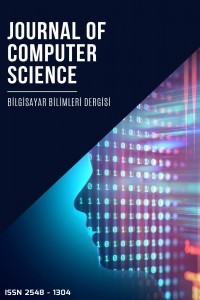MFCC Öznitelikleri ve Adaboost Topluluk Öğrenme Yöntemi Kullanılarak Uyku Seslerinin Sınıflandırılması
Adaboost, topluluk öğrenme, rastgele orman, MFCC, uyku sesleri
Classification of Sleep Sounds Using MFCC Features and Adaboost Ensemble Learning Method
Adaboost, ensemble learning, random forest, MFCC, sleep sounds,
___
- Adesuyi, T. A., Kim, B. M., & Kim, J. (2022). Snoring sound classification using 1D-CNN model based on multi-feature extraction. International Journal of Fuzzy Logic and Intelligent Systems, 22(1), 1-10.
- Akbal, E., & Tuncer, T. (2021). FusedTSNet: an automated nocturnal sleep sound classification method based on a fused textural and statistical feature generation network. Applied Acoustics, 171, 107559.
- Akyol, S., Yildirim, M., & Alatas, B. (2023). Multi-feature fusion and improved BO and IGWO metaheuristics based models for automatically diagnosing the sleep disorders from sleep sounds. Computers in Biology and Medicine, 157, 106768.
- Ayvaz, U., Gürüler, H., Khan, F., Ahmed, N., Whangbo, T., & Bobomirzaevich, A. (2022). Automatic speaker recognition using mel-frequency cepstral coefficients through machine learning. CMC-Computers Materials & Continua, 71(3).
- Ben-Israel, N., Tarasiuk, A., & Zigel, Y. (2010, August). Nocturnal sound analysis for the diagnosis of obstructive sleep apnea. In 2010 Annual International Conference of the IEEE Engineering in Medicine and Biology, (pp. 6146-6149). IEEE.
- Chattu, V. K., Manzar, M. D., Kumary, S., Burman, D., Spence, D. W., & Pandi-Perumal, S. R. (2018, December). The global problem of insufficient sleep and its serious public health implications. In Healthcare, (Vol. 7, No. 1, p. 1). MDPI.
- Chen, J., Dang, X., & Li, M. (2022, April). Heart Sound Classification Method based on Ensemble Learning. In 2022 7th International Conference on Intelligent Computing and Signal Processing, (pp. 8-13). IEEE.
- Christofferson, K., Chen, X., Wang, Z., Mariakakis, A., & Wang, Y. (2022, March). Sleep Sound Classification Using ANC-Enabled Earbuds. In 2022 IEEE International Conference on Pervasive Computing and Communications Workshops and other Affiliated Events, (pp. 397-402). IEEE.
- Davis, S., & Mermelstein, P. (1980). Comparison of parametric representations for monosyllabic word recognition in continuously spoken sentences. IEEE transactions on acoustics, speech, and signal processing, 28(4), 357-366.
- Freund, Y., & Schapire, R. E. (1997). A decision-theoretic generalization of on-line learning and an application to boosting. Journal of computer and system sciences, 55(1), 119-139.
- Freund, Y., Schapire, R., & Abe, N. (1999). A short introduction to boosting. Journal-Japanese Society For Artificial Intelligence, 14(771-780), 1612.
- Hajipour, F., Jozani, M. J., & Moussavi, Z. (2020). A comparison of regularized logistic regression and random forest machine learning models for daytime diagnosis of obstructive sleep apnea. Medical & Biological Engineering & Computing, 58, 2517-2529.
- Kılıç, E., & Erdamar, A. (2020). Destek vektör makineleri kullanarak uyku seslerinin çoklu sınıflandırılması. Journal of the Institute of Science and Technology, 10(4), 2474-2485.
- Kim, J. W., Cho, S. W., Lee, K., & Shin, J. Y. (2019). Correlation analysis of sleep breathing sound and polysomnographic features. ERJ Open Research, 5 : Suppl. 3, P55
- Martinez, J., Perez, H., Escamilla, E., & Suzuki, M. M. (2012, February). Speaker recognition using Mel frequency Cepstral Coefficients (MFCC) and Vector quantization (VQ) techniques. In Conielecomp 2012, 22nd International conference on electrical communications and computers (pp. 248-251). IEEE.
- McFee, B., Raffel, C., Liang, D., Ellis, D. P., McVicar, M., Battenberg, E., & Nieto, O. (2015, July). librosa: Audio and music signal analysis in python. In Proceedings of the 14th python in science conference (Vol. 8, pp. 18-25).
- Mohammed, E. A., Keyhani, M., Sanati-Nezhad, A., Hejazi, S. H., & Far, B. H. (2021). An ensemble learning approach to digital corona virus preliminary screening from cough sounds. Scientific Reports, 11(1), 1-11.
- Otsuka, Y., Kaneita, Y., Itani, O., Nakagome, S., Jike, M., & Ohida, T. (2017). Relationship between stress coping and sleep disorders among the general Japanese population: a nationwide representative survey. Sleep medicine, 37, 38-45.
- Sillaparaya, A., Bhatranand, A., Sudthongkong, C., Chamnongthai, K., & Jiraraksopakun, Y. (2022, November). Obstructive Sleep Apnea Classification Using Snore Sounds Based on Deep Learning. In 2022 Asia-Pacific Signal and Information Processing Association Annual Summit and Conference (pp. 1152-1155). IEEE.
- Vankara, J., Lavanya Devi, G. PAELC: Predictive Analysis by Ensemble Learning and Classification heart disease detection using beat sound. Int J Speech Technol, 23, 31–43 (2020). https://doi.org/10.1007/s10772-020-09670-6
- Yıldırım, M. (2022). MFCC Yöntemi ve Önerilen Derin Model ile Çevresel Seslerin Otomatik Olarak Sınıflandırılması. Fırat Üniversitesi Mühendislik Bilimleri Dergisi, 34(1), 449-457.
- Zhao, S., Zhang, Y., Xu, H., & Han, T. (2019). Ensemble classification based on feature selection for environmental sound recognition. Mathematical Problems in Engineering, 2019.
- ISSN: 2548-1304
- Yayın Aralığı: Yılda 2 Sayı
- Başlangıç: 2016
- Yayıncı: Ali KARCI
Yeşil Tedarikçi Seçiminde Hibrit Bulanık AHP ve Bulanık QFD Yaklaşımının Kullanılması
Candan UÇKUN, Nurdan DALGIÇ, Aytaç YILDIZ
YOLOv8 ile Demiryolu Hattı Çevresindeki Yabancı Cisimlerin Tespiti
Development of Text Summarization Method based on Graph Theory and Malatya Centrality Algorithm
Selman YAKUT, Cevher Tayyib BAKAN
Improved Reptile Search Algorithm for Optimal Design of Solar Photovoltaic Module
Davut İZCİ, Serdar EKİNCİ, Murat GÜLEYDİN
Türkçe Duygu Sınıflandırma İçin Transformers Tabanlı Mimarilerin Karşılaştırılmalı Analizi
Siber Güvenlikte T-Pot Honeypot Uygulanması: Kurumsal Ağ Üzerinde Örnek Durum Çalışması
Sağlık Hizmetindeki Robotlar İçin Blokzincir Destekli Görev Yönetimi: Webots Simülasyonu
Mehmed Oğuz ŞEN, Fatih OKUMUŞ, Fatih KOCAMAZ
Elma Yaprağı Hastalıklarının AlexNet Kullanılarak Derin Öğrenme Tabanlı Sınıflandırılması
Felix Olanrewaju BABALOLA, Nekabari Isabella KPAİ, Önsen TOYGAR
